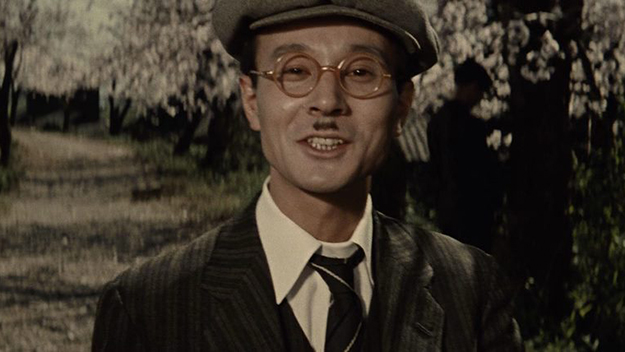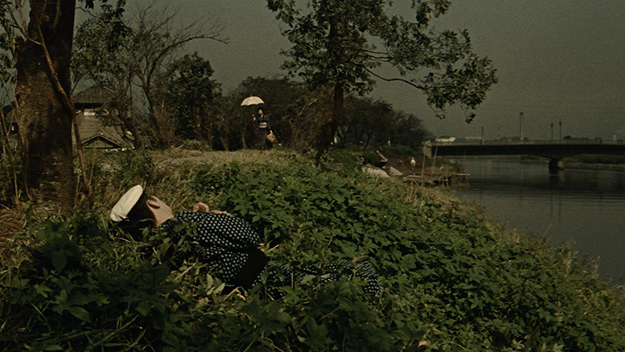TCM Diary: The Color of Ototo

Ototo (Kon Ichikawa, 1960)
Kon Ichikawa’s 1960 film Ototo cools the typically overheated juvenile delinquent drama into surely the most genteel example of that genre ever made. Unlike the angst-ridden cry for tenderness of Nicholas Ray’s Rebel Without a Cause or Ichikawa’s own paradigmatic and nihilistic entry in Japan’s troubled youth cycle, The Punishment Room (1956), Ototo is a careful, meticulous spelunking into the hidden character depths within a self-destructive family.
Like the autobiographical novel upon which its based, Ichikawa’s film adaptation (scripted by frequent Mikio Naruse collaborator Yoko Mizuki) unfolds in the 1930s, a decade that found Japan’s burgeoning middle-class adrift in a turbid social and cultural sea of modernity, materialism, and financial opportunity, roiling established tradition. For twenty-something Hekiro (Hiroshi Kawaguchi), unmarried daughter of a successful novelist, contemporary society’s obligations amount to endurable hypocrisy. Rather than follow the prescribed path to marriage and motherhood, she acts as default cook and housemaid to her emotionally unavailable work-at-home dad, her rheumatic and deeply insecure step-mother, and especially her sweet but heedless and impulse-driven teenage brother Gen (Keiko Kishi).
Nominally plotted along the choice-and-effect outcome of Gen’s increasingly criminal and violent acting-out, Ototo evolves into a kind of card-less poker game of accusatory bets and bluffs between parents and siblings. The elusive jackpot is the unconditional love and support that no one in the game, except for Hekiro, appears equipped to give or receive. “That kind of boy is often physically weak, psychologically twisted in nature, and is raised by an alcoholic father in a family where the parent’s love for the child is easily influenced by mood and feeling,” says the stepmother, parroting what the police (accurately) tell her after Gen’s most recent arrest. Like every adult in the film, she has her finger on or near the root cause of trouble but is too self-absorbed to actually do anything about it.

Ototo (Kon Ichikawa, 1960)
No matter how nimbly Hekiro navigates the ritualized social modesty expected of her, cruelty awaits around every corner. Gen’s assigned caseworker (the most creepy movie social worker until Mr. Deltoid in A Clockwork Orange) nearly rapes her. A department store detective underscores the seriousness of a false shoplifting accusation by demonstrating the whip he intends to use on her. Yet, when the film pivots into unabashedly melodramatic and tragic territory in its final act, Hekiro is the best prepared to roll with the fatal blow.
Here, as in every one one of his ’Scope pictures, Ichikawa’s command of widescreen filmmaking is in a class by itself. Landscapes and interiors are depicted in precise yet natural intersecting lines of architecture, flora, sky and eye-line. A magnificently shot and staged rainy-day walk to school, interpolated within the opening credits, reaffirms that Kon Ichikawa did for umbrellas what Sergio Leone did for Stetsons. The director’s tenacious commitment to avoiding repeating compositions—repositioning the camera and reframing rather than relying on cyclical master shot, close-up, coverage—adds a seductive visual progression and gravitas to the film’s many dialogue scenes.
“Everyone is essentially alone”, Ichikawa wrote in a 1960 director’s statement that made the festival rounds with Ototo. “Indeed, familial love is based upon the premise of loneliness.” The director maintained that in order to realize his unapologetically despairing take on family dynamics, cast and crew “were joined in the determination not to let this become just another formula film.”

Ototo (Kon Ichikawa, 1960)
Ichikawa and his peerless cinematographer Kazuo Miyagawa (a one-man pantheon of Japanese DPs) sought to further cloister their drama by radically controlling color. Inspired by Oswald Morris’s hard-edged but soft-hued look for John Huston’s Moby Dick, Miyagawa, who’d began his career as a film lab technician, conjured a uniquely analog photo-chemical sleight of hand. The exposed film negative (or possibly a negative struck from the camera original—his precise original recipe is long gone) was printed without going through an ordinarily obligatory chemical stage intended to bleach out extraneous silver crystals in the film emulsion and thereby fix colors within their conventional chromatic limits. The result of this process, variously called “bleach bypass,” “skip-bleach,” “silver retention,” and a handful of proprietary variants like Technicolor’s “ENR,” is an austere, muted, subtly grainy color palette framed within sharply defined black details.
“Great care was also taken to match the sets with the color scheme of the film,” Ichikawa wrote in 1960. According to the director, Miyagawa sought to take full advantage of his lab experiment by lighting Ototo as if it were in black and white. The art department strove to subtract and control onscreen hues and textures with appropriate design, color, and material choices on the sound stage and on location. For a depiction of bourgeois household struggles it’s an almost perversely un-decorative approach. When Gen spills red ink on a tatami mat, it’s as if it’s the first time that color has existed in the world of the film. A pair of brightly labeled, American-branded cans of fruit fairly throbs in close-up. The degree to which the resulting radical look quickly becomes subliminal is a testament to the ingenuity of everyone tasked with realizing it on set as well as in the lab.
Both Moby Dick and William Wellman’s Track of the Cat achieved similar effects by other means during the prior decade. And after Ototo, Miyagawa’s bleach-bypass process continued to crop up when mainstream feature filmmakers sought an additional level of austerity. Michael Radford’s 1984, David Fincher’s Se7en, and Steven Spielberg’s Saving Private Ryan each employs the photochemical approach. Now, of course, a similar result would be pursued through digital color grading. But Ototo, like its characters, stands alone within the narratively heterogeneous family of cracked color movies in using a trick of physics and film craft to depict life’s colorless shadows of grief and acceptance with honesty and ingenuity.
Bruce Bennett is a TV writer and producer and recovering film critic based in Woodside, NY.







